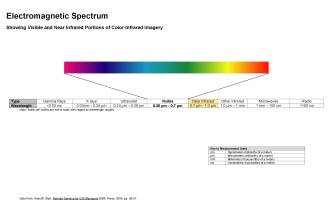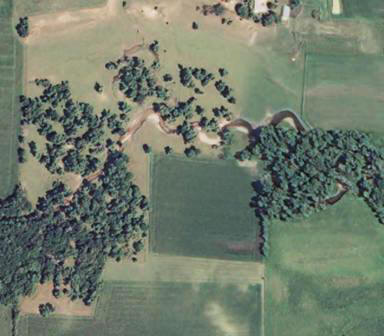Color-Infrared (CIR) Imagery
What is it?
|
The human eye can see electromagnetic radiation (a.k.a. light) from only a very
small portion of the electromagnetic spectrum. To "see" beyond this range we
need instruments and cameras that can detect and then translate invisible
radiation into the familiar colors of the rainbow. Color-infrared (CIR) imagery uses a portion of the electromagnetic
spectrum known as near infrared that ranges from 0.70
μm to 1.0 μm
(0.7 to 1.0 micrometers or millionths of a meter),
just beyond the wavelengths for the color red. (See diagram at right) |
 Click on image above to see full-size version
|
||||||||||
|
There are millions of colors of visible light yet each is simply a different combination of the three primary colors: blue, green and red. The invisible near infrared light of CIR can be "seen" by shifting it and the primary colors over as shown at left. Near infrared wavelengths become visible as red while red wavelengths appear as green and green as blue. Blue wavelengths are shifted out of the visible portion of the spectrum and so they appear as black. On CIR imagery vegetation appears red while water generally appears black with artificial structures like buildings and roads showing as a light blue-green.
|
||||||||||
Interpreting CIR ImageryThe following is a general summary of what the different colors in CIR aerial
imagery represent: |
|
||||||||||
What is it good for? |
|||||||||||
|
CIR imagery is good at penetrating atmospheric haze and for determining the health of vegetation. CIR imagery is also good for:
From: Aronoff, Stan, Remote Sensing for GIS Managers ESRI Press, 2005, p. 64. Click here for more examples of how CIR imagery is used.
|
|
||||||||||
Need more info?
See the following links for more information on CIR imagery:
- The USGS' Understanding Color-Infrared Photographs Fact Sheet
- The Farm Service Agency's Four Band Digital Imagery Information Sheet
- Wikipedia's info on Infrared Photography
Return to MnGeo's first-stop Aerial Photography page.



